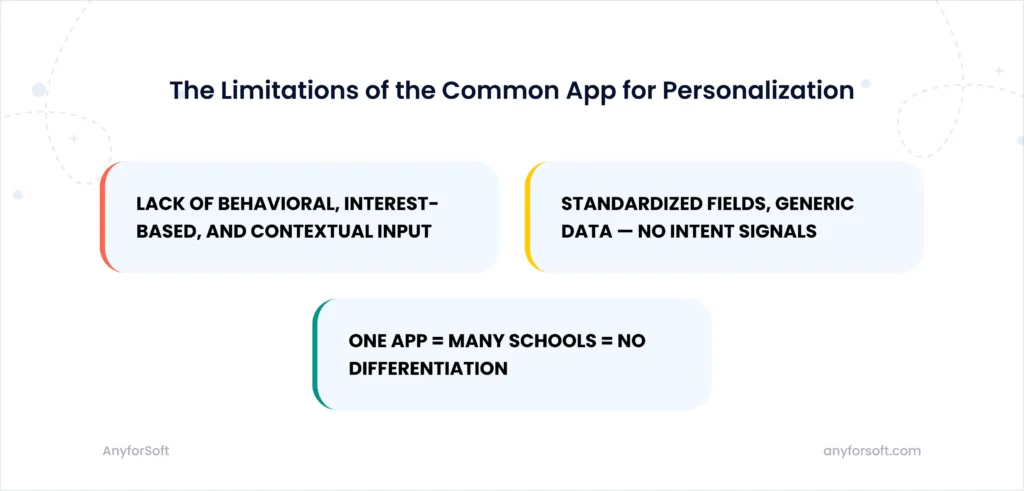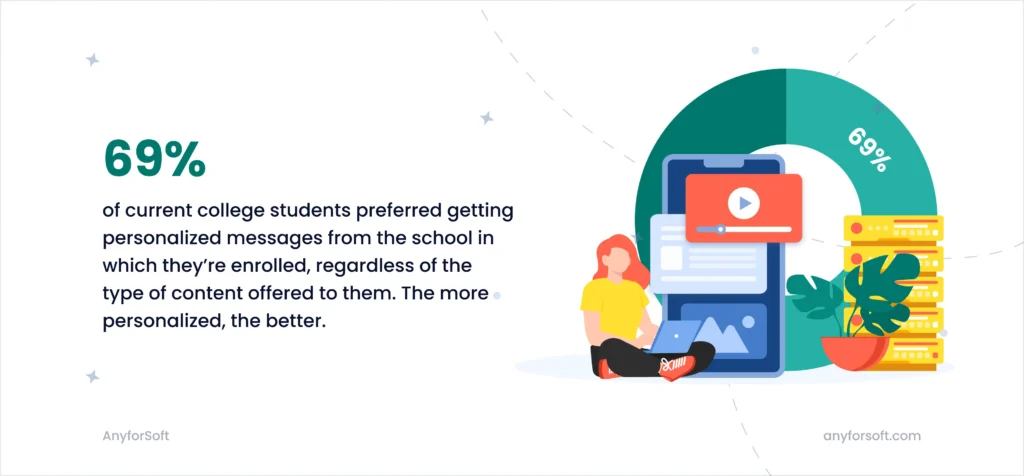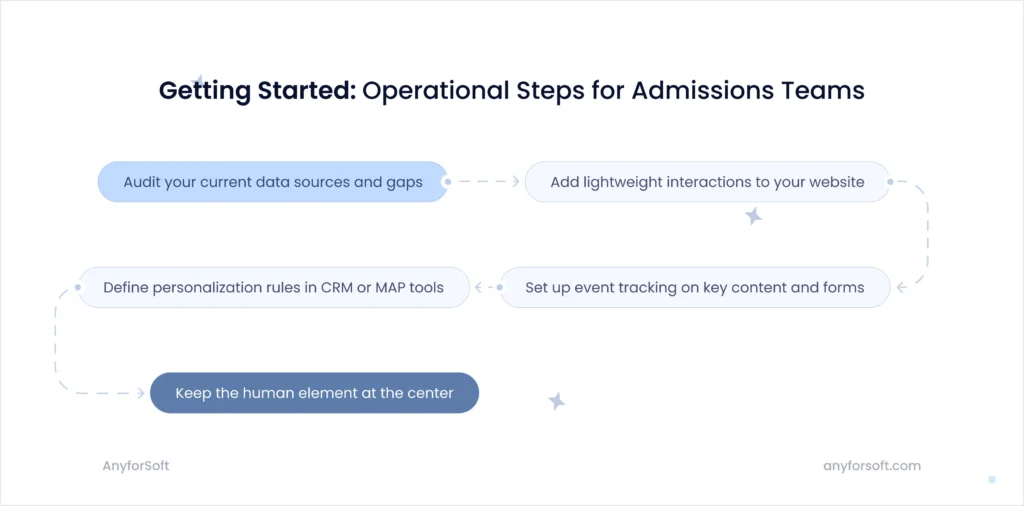Personalization Challenges with Common App Applicants — and How to Solve Them
Each year, more than a million students submit applications through the Common App. For admissions teams, it’s a helpful tool – it consolidates key academic records, activities, and demographic details in one standardized format. But that standardization is also the problem.
When every application looks nearly identical, it becomes difficult to understand what sets one student apart from another. Admissions officers are left with structured data but very little insight into an applicant’s real interests, motivations, or decision-making process.
That gap has consequences. Students increasingly expect schools to recognize their individuality. A survey conducted by Concept3D among 500 first- and second-year college students and 500 high school students in 2024 showed that 67% of prospects expect personalized communication from colleges. Without the right signals, personalization risks becoming little more than mail-merge emails with a first name swapped in.
This article looks at why Common App data alone isn’t enough for tailored admissions outreach—and how to solve that challenge by enriching applications with behavioral and contextual signals. We’ll cover:
- Why the Common App makes personalization difficult
- How to add depth with website behavior, quiz results, and chat interactions
- The role of integrations, progressive profiling, and event tracking
- Real-world use cases of turning generic outreach into meaningful engagement
The Limitations of the Common App for Personalization

Standardized fields, generic data — no intent signals
The biggest strength of the Common App is also its weakness: it’s standardized. Every student submits the same fields, and every institution receives the same inputs. For admissions operations, this makes it easier to compare applicants side by side. But when it comes to personalization, it’s a dead end.
- You know their test scores, but not their learning style.
- You know their extracurriculars, but not what sparked their interest in them.
- You know they applied, but not what persuaded them to click “submit.”
What specific aspects of your school caught their attention? Or how they’re weighing you against peer institutions?
Without intent signals, your outreach risks sounding like a mass email blast. And applicants notice.
Lack of behavioral, interest-based, and contextual input
Applicants spend far more time on your digital channels than they do filling out the Common App. They browse your program pages, compare financial aid resources, register for webinars, attend webinars, or ask questions in live chat. Each of those actions provides a clue about their interests and priorities.
But none of this activity is reflected in the application. If your team relies only on Common App data, you miss opportunities to:
- See which programs or majors the applicant explored on your website
- Understand whether they’re comparing financial aid resources across schools
- Track engagement with virtual campus tours, webinars, or blogs.
This gap explains why admissions CRM personalization often falls short. Without enrichment, every applicant gets the same “thank you for applying” email – no matter their interests or concerns.
One app = many schools = no differentiation
From the applicant’s perspective, that’s efficient. From your perspective, it creates a personalization wall. How do you differentiate outreach when:
- The personal essay is addressed to “admissions committees,” not you
- The activities list doesn’t reveal which of your programs they’re drawn to
- The demographic info doesn’t explain cultural or academic fit with your school
This “one-to-many” format is why so many admissions teams feel stuck. Without additional context – such as which of your programs they explored or what questions they asked in your chatbot – personalization means plugging first names into email templates. But personalization should go far beyond that – shaping messaging around Common App applicant insights that only your digital ecosystem can provide.
Put simply, these are the Common App data challenges admissions offices have to overcome if they want to compete in today’s applicant-centered landscape.

Enriching the Common App with Dynamic Behavioral Data
Tracking website behavior to identify key interests
When students land on your website, they leave behind a trail of digital signals. Which program pages do they view? How much time do they spend on your admissions requirements page versus your student life section? Do they return multiple times to explore a particular major?
These signals provide a clearer picture of intent than grades or test scores alone. With proper event tracking in place, admissions teams can see patterns such as:
- Applicants spending significant time on STEM program pages (indicating academic focus).
- Repeated visits to financial aid calculators (showing cost sensitivity).
- Engagement with student housing or athletics pages (highlighting lifestyle priorities).
Using behavioral data in admissions outreach helps tailor communication. For example, a student who repeatedly checks out your nursing program should receive program-specific follow-up emails rather than broad campus overviews. This shift transforms outreach from “general marketing” to dynamic content for prospective students that feels genuinely relevant.
Using pre-enrollment quizzes to segment by motivation
Quizzes may seem like a small tactic, but they’re powerful for segmentation. By inviting prospective students to complete short assessments – such as “Which program best matches your interests?” or “What type of campus community are you looking for?” – you gather data the Common App never captures.
These quizzes can reveal:
- Whether a student is career-driven, socially motivated, or academically exploratory.
- Which values matter most (affordability, prestige, location, community).
- How close are they to making a decision?
This is progressive profiling in action. Instead of asking everything at once, you collect pieces of information over time in a way that feels natural to students. When integrated into your admissions CRM personalization strategy, quiz outcomes can automatically sort applicants into tailored messaging tracks.
Capturing chatbot interactions to surface hidden questions
Chatbots are increasingly common on university websites, and their logs are a goldmine of insights. Unlike application forms, chat transcripts capture what students are truly worried about – often questions they don’t put in essays or official emails.
Typical patterns include:
- International students asking about visa support.
- First-generation students inquiring about financial aid.
- Transfer students clarifying credit recognition policies.
By analyzing chat interactions, admissions teams gain access to applicant engagement signals that can be routed directly into their CRM. Instead of a generic follow-up, counselors can address the exact questions a student raised in chat – closing the loop between inquiry and personalized response.
Syncing UTM tags and email activity for source attribution
Another area of personalization is understanding how a student found you. Was it through a digital ad, a virtual fair, or an organic search? UTM tags on links help admissions teams track back to the source.
When combined with email activity, you can see not just where a student came from but how they interact with ongoing outreach:
- Did they open event invites but not program brochures?
- Do they click on financial aid resources but not student life content?
- Are they more responsive on mobile or desktop?
These patterns feed into admissions data enrichment, so schools can tailor follow-ups. A student who comes in through a scholarship campaign and consistently engages with aid emails, for example, shouldn’t get generic campus life promotions as their primary communication.
Building a Smarter Admissions Tech Stack
Collecting behavioral signals is only half the battle. The real challenge is making those signals actionable across your admissions ecosystem. That means connecting data from websites, quizzes, and chatbots with your student recruitment technology stack so every interaction feels personal and consistent.
Integrations with CRM, MAP, and SIS Platforms
Most admissions teams already rely on a core set of tools:
- CRM (Customer Relationship Management): Tracks applicants, communications, and counselor interactions.
- MAP (Marketing Automation Platform): Sends campaigns, nurtures leads, and manages outreach flows.
- SIS (Student Information System): Stores official academic and enrollment records.
On their own, these systems don’t “talk” to each other. Integrations are what make enrollment marketing automation possible. When website behavior, quiz results, or chatbot questions are pushed into the CRM, they stop being isolated signals and start shaping outreach.
Event tracking and progressive profiling tactics
Event tracking is the backbone of personalization. It captures specific applicant actions – downloading a course guide, signing up for a webinar, revisiting the tuition calculator – and logs them as discrete data points.
When tied to progressive profiling, it ensures you’re not overwhelming students with long forms but gradually building a rich profile over time. For example:
- First visit: capture name and email for newsletter signup.
- Second visit: prompt a quiz or interest survey.
- Third visit: encourage registration for a virtual event.
By the time a student applies via the Common App, your CRM already has context about what drew them to you – making Common App applicant insights far more actionable
Connecting identity across channels with CDPs or tags
A common problem is fragmented identities. A student might:
- Download a brochure with a personal Gmail address.
- Chat with your bot using their school email.
- Apply through the Common App with yet another address.
Without stitching these touchpoints together, the same student looks like three different leads. This is where Customer Data Platforms (CDPs) or tags come in. They connect digital identities across sessions and channels so all interactions map back to the same applicant record.
The benefit? Truly personalized communication. When identity is unified, counselors can see the full journey: what content a student engaged with, what questions they asked, and how their interests evolved. That’s when personalization shifts from superficial to strategic.
Real-World Use Cases: From Blind Outreach to Intelligent Engagement
When you enrich Common App data, admissions teams have the context to create communication that feels relevant, not generic. Below are several examples of how schools are already making the shift.
Creating dynamic email campaigns based on the content viewed
Two applicants may look identical on the Common App but behave very differently online. One spends most of their time exploring engineering program pages; the other focuses on student life and athletics. Sending both the same “Discover our campus” email isn’t going to cut it.
With event tracking linked to your CRM, you can deliver content that matches their actual browsing behavior:
- Academic explorers get course guides, faculty profiles, and research highlights.
- Students interested in culture get stories about clubs, residence life, and athletics.
- Applicants revisiting the tuition calculator get scholarship reminders and aid workshop invitations.
This approach to using behavioral data in admissions outreach helps ensure that communication lands in the right context.
Segmenting messaging based on quiz outcomes
A short pre-enrollment quiz can provide more segmentation value than a dozen demographic fields. Even a single question such as “What matters most in your college decision?” can direct applicants into different engagement tracks.
- Career-focused students get internship stories and alumni outcomes.
- Community-driven students get invitations to peer-led events.
- Cost-sensitive applicants get scholarships and aid options.
This type of admissions data enrichment shows students you recognize their priorities, not just their statistics.
Routing applicants to admissions counselors by interest cluster
Applicants don’t just want tailored emails – they want meaningful conversations. Routing students to the right counselor can make a big difference.
- STEM applicants talk to counselors who specialize in science and engineering.
- International students are assigned to staff who know about visas and global support.
- First-generation students meet counselors who understand affordability and mentorship pathways.
This human-centered personalization builds trust and often accelerates enrollment decisions.
Moving Beyond “Blind Outreach”
In many admissions offices, outreach still follows a generic cycle: the same welcome emails, the same reminders, counselor assignments based on convenience. With enriched data, that cycle shifts:
- Emails highlight specific interests already shown online.
- Campaigns are segmented by motivation rather than demographics.
- Counselor conversations reflect prior engagement and questions.
Our observations show that when teams do this, applicant engagement rises and conversations feel more real.
AnyforSoft has extensive experience working with the education industry. For years, our team has been skillfully solving a wide variety of tasks for educational institutions, so we have faced various challenges and are well aware of how a change in one approach (for example, personalization or automation) can change how your institution operates, grows, and develops.
Getting Started: Operational Steps for Admissions Teams
Understanding how to personalize Common App applicants starts with small, practical steps. You don’t need to overhaul your system overnight. Many admissions offices succeed by layering in new signals incrementally and connecting them to existing CRMs or marketing platforms.

Audit your current data sources and gaps
Make a list of the data sources you already use – Common App files, campus visits, webinar sign-ups, website analytics, CRM activity – and note the gaps.
Questions to ask yourself:
- Which signals are already in your CRM?
- Where do staff use spreadsheets or manual updates?
- What data would be most useful for personalization but isn’t being captured?
This will usually show you the low-hanging fruit.
Add lightweight interactions to your website
Small interactions can be powerful:
- Short “What are you most interested in studying?” polls.
- Quick quizzes on majors.
- Micro-forms that offer guides in exchange for an email.
Over time, these add a new layer of applicant engagement signals without overwhelming visitors.
Set up event tracking on key content and forms
Start by identifying 5-7 high-value actions such as:
- Downloading brochures.
- Using tuition calculators.
- Registering for webinars.
- Viewing faculty or research pages.
Make sure these actions are logged in your CRM so counselors can see the bigger picture.
Define personalization rules in CRM or MAP tools
Even a few basic automations can make communication more relevant:
- If a student downloads a financial aid guide → send aid-focused resources.
- If they attend a STEM webinar → enroll them in a STEM nurture flow.
- If they ask about visas in chat → flag them for international counselor follow-up.
These rules operationalize admissions CRM personalization without requiring large-scale system changes.
Keep the human element at the center
Technology provides the signals, but people build the relationships. Counselors should use enriched data as conversation starters, not scripts. When staff combine insights with genuine empathy, applicants feel recognized instead of processed.
Conclusion
The Common App is one of the most widely used tools in higher education admissions. Its standardized format simplifies application management, but it also limits personalization. Without context about an applicant’s interests, motivations, and decision-making process, outreach sounds generic – and students notice.
The good news is that Common App personalization doesn’t require reinventing the admissions process. By enriching Common App files with behavioral data from website interactions, quiz results, chat conversations, and marketing attribution, admissions teams can uncover the missing signals that matter most.
Paired with the right student recruitment technology – integrated CRMs, marketing automation, event tracking, and progressive profiling – these signals become the foundation of tailored communication.
We’ve seen firsthand how this shift transforms applicant engagement. Campaigns become more relevant, counselor conversations feel more intentional, and students feel like you get them.
So for admissions teams, the message is simple: start small, connect the dots, and build from there. Each additional signal makes outreach more targeted and relationships more meaningful. Over time, the personalization gap created by the Common App becomes an opportunity – to stand out, show you care, and guide applicants to the right decision.
The schools that get this right will not only grow their numbers but also build stronger relationships with the students who are the best fit for their institution.
If you want to enrich admissions data and explore how to personalize Common App applicants at scale, the AnyforSoft team is here to help. We specialize in custom software development, CRM integration, eLearning platforms, and chatbot solutions tailored to the education sector. Let’s talk about how we can support your admissions team in building smarter, more personalized applicant journeys.








